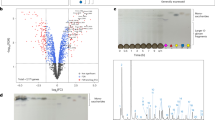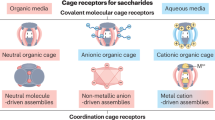Abstract
Carbohydrate microarrays have received considerable attention as an advanced technology for the rapid analysis of carbohydrate–protein interactions. This protocol provides detailed procedures for the preparation of carbohydrate microarrays by immobilizing hydrazide-conjugated carbohydrates on epoxide-derivatized glass slides. In addition, we describe the use we make of these microarrays in glycomics research. Unlike other techniques that require large amounts of samples and long assay times, carbohydrate microarrays are used to carry out the rapid assessment of a number of carbohydrate-recognition events with tiny amounts of carbohydrate samples. Furthermore, the microarray technology is also utilized for the rapid assay of enzyme activities. We are able to routinely prepare carbohydrate microarrays within 12 h by using hydrazide-conjugated carbohydrates and apply these microarrays for the studies of glycan–protein interactions within 8 h.
This is a preview of subscription content, access via your institution
Access options
Subscribe to this journal
Receive 12 print issues and online access
$259.00 per year
only $21.58 per issue
Buy this article
- Purchase on SpringerLink
- Instant access to full article PDF
Prices may be subject to local taxes which are calculated during checkout





Similar content being viewed by others
References
Bertozzi, C.R. & Kiessling, L.L. Chemical glycobiology. Science 291, 2357–2364 (2001).
Varki, A. Biological roles of oligosaccharides: all of the theories are correct. Glycobiology 3, 97–130 (1993).
Roth, J. Protein N-glycosylation along the secretory pathway: relationship to organelle topography and function, protein quality control, and cell interactions. Chem. Rev. 102, 285–303 (2002).
Smith, A.E. & Helenius, A. How viruses enter animal cells. Science 304, 237–242 (2004).
Fuster, M.M. & Esko, J.D. The sweet and sour of cancer: glycans as novel therapeutic targets. Nat. Rev. Cancer 5, 526–542 (2005).
Lasky, L.A. Selectins: interpreters of cell-specific carbohydrate information during inflammation. Science 258, 964–969 (1992).
Scanlan, C.N., Offer, J., Zitzmann, N. & Dwek, R.A. Exploiting the defensive sugars of HIV-1 for drug and vaccine design. Nat. Insight 446, 1038–1045 (2007).
Lis, H. & Sharon, N. Lectins: cell-agglutinating and sugar-specific proteins. Science 177, 949–959 (1972).
McCoy, J.P., Jr, Varani, J. & Goldstein, I.J. Enzyme-linked lectin assay (ELLA): use of alkaline phosphatase-conjugated Griffonia simplicifolia B4 isolectin for the detection of alpha-D-galactopyranosyl end groups. Anal. Biochem. 130, 437–444 (1983).
Duverger, E., Frison, N., Roche, A.C. & Monsingny, M. Carbohydrate-lectin interactions assessed by surface plasmon resonance. Biocheimie 85, 167–179 (2003).
Dam, T.K. & Brewer, C.F. Thermodynamic studies of lectin-carbohydrate interactions by isothermal titration calorimetry. Chem. Rev. 102, 387–430 (2002).
Wormald, M.R. et al. Conformational studies of oligosaccharides and glycopeptides: complementarity of NMR, X-ray crystallography, and molecular modeling. Chem. Rev. 102, 371–386 (2002).
Park, S. & Shin, I. Fabrication of carbohydrate chips for studying protein-carbohydrate interactions. Angew. Chem. Int. Ed. 41, 3180–3182 (2002).
Wang, D., Liu, S., Trummer, B.J., Deng, C. & Wang, A. Carbohydrate microarrays for the recognition of cross-reactive molecular markers of microbes and host cells. Nat. Biotechnol. 20, 275–281 (2002).
Fukui, S., Feizi, T., Galustian, C., Lawson, A.M. & Chai, W. Oligosaccharide microarrays for high-throughput detection and specificity assignments of carbohydrate-protein interactions. Nat. Biotechnol. 20, 1011–1017 (2002).
Houseman, B.T. & Mrksich, M. Carbohydrate arrays for the evaluation of protein binding and enzymatic modification. Chem. Biol. 9, 443–454 (2002).
Park, S., Lee, M.R., Pyo, S.J. & Shin, I. Carbohydrate chips for studying high-throughput carbohydrate-protein interactions. J. Am. Chem. Soc. 126, 4812–4819 (2004).
Lee, M.R. & Shin, I. Fabrication of chemical microarrays by efficient immobilization of hydrazide-linked substances on epoxide-coated glass surfaces. Angew. Chem. Int. Ed. 44, 2881–2884 (2005).
Park, S. & Shin, I. Carbohydrate microarrays for assaying galactosyltransferase activity. Org. Lett. 9, 1675–1678 (2007).
Lee, M.R. & Shin, I. Facile preparation of carbohydrate microarrays by site-specific, covalent immobilization of unmodified carbohydrates on hydrazide-coated glass slides. Org. Lett. 7, 4269–4272 (2005).
Shin, I., Cho, J.W. & Boo, D.W. Carbohydrate arrays for functional studies of carbohydrates. Comb. Chem. High Throughput Screening 7, 565–574 (2004).
Shin, I., Park, S. & Lee, M.R. Carbohydrate microarrays: an advanced technology for functional studies of glycans. Chem. Eur. J. 11, 2894–2901 (2005).
Shin, I., Tae, J. & Park, S. Carbohydrate microarray technology for functional glycomics. Curr. Chem. Biol. 1, 187–199 (2007).
Shin, I. Carbohydrate microarrays for high-throughput analysis of carbohydrate-protein interactions. in Protein–Carbohydrate Interactions in Infectious Diseases (ed. Carole A. Bewley) 221–246 (RSC Publishing, Cambridge, UK, 2006).
Blixt, O. et al. Printed covalent glycan array for ligand profiling of diverse glycan binding proteins. Proc. Natl. Acad. Sci. USA 101, 17033–17038 (2004).
de Paz, J.L., Noti, C. & Seeberger, P.H. Microarrays of synthetic heparin oligosaccharides. J. Am. Chem. Soc. 128, 2766–2767 (2006).
Disney, M.D. & Seeberger, P.H. The use of carbohydrate microarrays to study carbohydrate-cell interactions and to detect pathogens. Chem. Biol. 11, 1701–1707 (2004).
Takahashi, T., Adachi, M., Matsuda, A. & Doi, T. Combinatorial synthesis of trisaccharides via solution-phase one-pot glycosylation. Tetrahedron Lett. 41, 2599–2603 (2000).
Sharma, G.V.M. & Krishna, P.R. A practical synthesis of 2-azidoethyl α-glycosides: useful spacer-arm glycosides for the synthesis of neoglycoconjugates. Carbohydr. Res. 243, 393–397 (1993).
Fazio, F., Bryan, M.C., Blixt, O., Paulson, J.C. & Wong, C.H. Synthesis of sugar arrays in microtiter plate. J. Am. Chem. Soc. 124, 14397–14402 (2002).
Moon, J.H., Shin, J.W., Kim, S.Y. & Park, J.W. Formation of uniform aminosilane thin layer: an imine formation to measure relative surface density of the amino group. Langmuir 12, 4621–4624 (1996).
Acknowledgements
This work was supported by grants from the NRL and Protein Chip Technology programs of MOST/KOSEF. S.P. thanks the BK21 program (KRF).
Author information
Authors and Affiliations
Corresponding author
Supplementary information
Supplementary Methods
Fabrication of Carbohydrate Chips and Their Use to Probe Protein-Carbohydrate Interactions (PDF 76 kb)
Rights and permissions
About this article
Cite this article
Park, S., Lee, MR. & Shin, I. Fabrication of carbohydrate chips and their use to probe protein–carbohydrate interactions. Nat Protoc 2, 2747–2758 (2007). https://doi.org/10.1038/nprot.2007.373
Published:
Issue date:
DOI: https://doi.org/10.1038/nprot.2007.373



